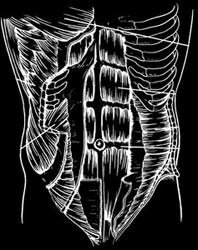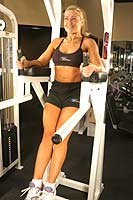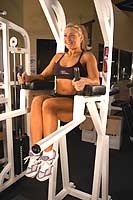While trying to achieve that clearly defined six pack during the course of a lean-down program, it is usually the goal to preserve as much muscle mass as possible, while simultaneously reducing the level of bodyfat and water retention. This entails either eating smaller, more frequent meals, or increasing the level of expended energy through more intense exercise.
The seasoned professional does both, with regard to diet and exercise. Caloric consumption is reduced, while energy expenditure is increased. This allows one to be in caloric deficit and lose "weight". Assuming that one's exercise regiment and macronutrient levels (protein, carbohydrate, fat) are sufficient, the only remaining factor would be that of shrinking the stomach, and tightening up the core muscles.
How Does One Go About Shrinking The Stomach?
Have you ever gone really strict on your diet for a few days, to the point where your physique was getting pretty tight, and you started to feel a little bit tighter in the midsection… and then, before you knew it, you really went ALL out and totally pigged out? I'm sure a lot of you have been there.
You feel bloated, and you can usually "feel" your stomach enlarge and swell, like a balloon. When you consistently eat small, frequent meals "every 2-3 hours", and don't "pig out", your stomach gradually begins to shrink itself, and when this is combined with rigorous abdominal workouts, and cardiovascular exercise, the abdominal muscles begin to show themselves in their true form. You can flex them in different positions, make them pop out, showcase oblique striations, and for the really conditioned individuals perform that famous "vacuum" pose, which requires a lot of strength in the transverse abdominis.
Your "Core" Consists Of Four Parts:
- Rectus Abdominis
- Transverse Abdominis
- Obliques
- Lower Back
In order to have the tightest midsection, all of these muscles must be conditioned, so that each part of your core can function together in its strongest, providing the tightness required to support the body through intense exercise, as well as showcase the tightness in the form of clearly delineated definition. But here, we are going to focus on the first and second parts of the core, namely your rectus, and transverse abdominis regions.
 Your rectus abdominis are those six or eight "ravioli-like" muscles that everyone calls a "sixpack". Strengthening these will be beneficial because a firm and conditioned rectus abdominis will of course look nice, but not nearly as good as when all the other core muscles are conditioned as well.
Your rectus abdominis are those six or eight "ravioli-like" muscles that everyone calls a "sixpack". Strengthening these will be beneficial because a firm and conditioned rectus abdominis will of course look nice, but not nearly as good as when all the other core muscles are conditioned as well.
The transverse abdominis is one of the most overlooked parts of the abdominal region, and quite possibly the most important I see loads of bodybuilders strapping on weight belts and bouncing up and down with 5 and 6 plate squats, when they cant even perform a single rep without a weight belt. This is absolutely absurd, as the transverse abdominis is the "weight belt" that you are born with!
It is the sheet of muscle "underneath" your sixpack which supports your organs and "core". Strengthening this muscle will allow you to have more definition in your sixpack, as well as allow you to handle more weight in almost all complex lifts. Try pulling your stomach in and bringing your belly button down to your back without flexing your sixpack.
Just flatten your stomach, and hold it. That's the transverse working. Quite a different feeling, huh? When you can suck your stomach in for an extended period of time WHILE flexing your rectus abdominis, you can create a lot of different looks with your abs that will involve deeper cuts, more "eye popping" abdominals, and a smaller, tighter waistline.
The Exercises
Try doing a set of roman chair leg raises, hanging leg raises, or crunches AFTER your morning cardio when you've burned off all your food.
While doing morning cardio after a few days of strict dieting, if you pay attention to your stomach, you'll notice that you have an easier time flattening it and holding it in.
Keep this feeling in mind, and also note the feeling you get if you gorge on food and overstuff yourself. Become aware of how this feels, and also know what it "feels" like when your stomach is small. Let's say for example, that your stomach is a little bigger than your fist, or even the size of TWO of your fists. If you go and get 3 hamburgers and a large fries at McDonald's, don't you think that if you put all that food in a pile, it might just be a little bit bigger than the area inside your stomach? Of course!
So what would happen if you consumed all that food? You would be "stretching" your stomach, and getting farther away from your goal. But what if by some unfortunate chance, you couldn't eat anything other than McDonalds due to a situation beyond your control, but didn't want to worry about stretching out your stomach.
Well you figure a hamburger with no bun and a few little fries, although not the best thing in the world, would take up a lot less area than 3 burgers with buns, large fries, soda, and whatever else Ronald McDonald tried to make you stuff your face with.
Conclusion
So now you have a gauge for your dieting/leaning down progress. Is your stomach getting progressively flatter, or do you notice that you keep messing up your diet at the wrong times, and "stretching" your stomach out through over-eating? Learn the art of "moderation", fist-sized portions of cheat foods, and your quest for that tight midsection will be a lot easier than ever before.


